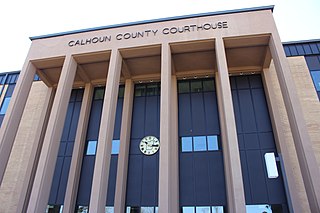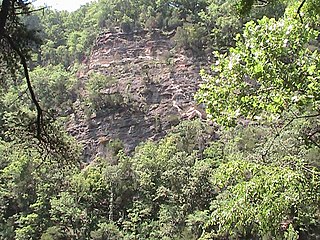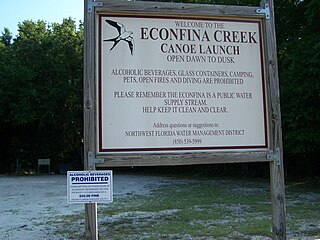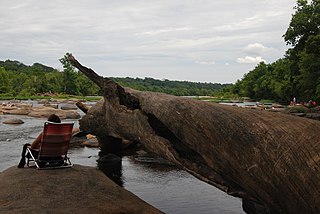
Calhoun County is a county located in the U.S. state of Florida. As of the 2020 census, the population was 13,648, making it the fifth-least populous county in Florida. Its county seat is Blountstown.

Jackson County is a county located in the U.S. state of Florida, on its northwestern border with Alabama. As of the 2020 census, the population was 47,319. Its county seat is Marianna.

Marianna is a city in and the county seat of Jackson County, Florida, United States, and it is home to Chipola College. The official nickname of Marianna is "The City of Southern Charm". The population was 6,245 at the 2020 census.

The White River is an American two-forked river that flows through central and southern Indiana and is the main tributary to the Wabash River. Via the west fork, considered to be the main stem of the river by the U.S. Board on Geographic Names, the White River is 362 miles (583 km) long. Indiana's capital, Indianapolis, is located on the river. The two forks meet just north of Petersburg and empty into the Wabash River at Mount Carmel, Illinois.

The Watauga River is a large stream of western North Carolina and East Tennessee. It is 78.5 miles (126.3 km) long with its headwaters in Linville Gap to the South Fork Holston River at Boone Lake.

The Jump River is a small rocky river in north-central Wisconsin. In the late 19th century it was used to drive logs down to the Chippewa River. Today it is recreational, rambling through woods and farmlands, used mostly by fishermen and paddlers.
Chason is a small unincorporated community in northwest Calhoun County, Florida, United States.

The Chattooga River is the main tributary of the Tugaloo River.

The Huron–Clinton Metroparks system is a regional park system in Metro Detroit in the U.S. state of Michigan. The park system includes 13 parks totaling more than 24,000 acres (97 km2) arranged along the Huron River and Clinton River forming a partial ring around the metro area. Plans are in development to finish the ring by building hike/bike trails to connect all the parks as a green belt. The parks draw about 7.5 million visitors a year, down from a peak of 10 million in 2009. The park system is primarily tax-funded with a $50 million annual budget. The system provides employment for 200 full-time and part-time employees year-round and 1,000 additional summer workers. The rivers are prime fishing and canoeing streams with Delhi Metropark including a short rapids, which while runnable, is the only point other than dams on either stream normally portaged.

The San Gabriel River is a river that flows through central Texas, USA. The San Gabriel River is formed in Georgetown by the confluence of the North Fork San Gabriel and the South Fork San Gabriel, both of which originate in Burnet County. There are two major impoundments of the river: Lake Georgetown along the North Fork, and Granger Lake, about 25 miles (40 km) below the confluence. Both are U.S. Army Corps of Engineers impoundments. The San Gabriel River joins the Little River five miles south of Cameron which then meets the Brazos River northwest of College Station. There is a city park in Georgetown at the confluence of the North and South Forks, with a well-known local swimming spot located just upriver from the confluence on the South Fork.
Rock Springs Run State Reserve is a 14,000-acre (5,700 ha) State Park in the U.S. state of Florida. The main entrance is located about 30 miles (48 km) north of Orlando in Sorrento, 3 miles (4.8 km) west of the Wekiva River bridge on State Road 46 and extends into Orange and Seminole Counties to the south. The park contains a number of Indian mounds, pine flatwoods, swamps and artesian springs, and a number of creeks and rivers. Among them are Seminole Creek, Wekiwa Springs Run, Rock Springs Run, and the Wekiva River.

Conewago Creek is an 80.2-mile-long (129.1 km) tributary of the Susquehanna River in Adams and York counties in Pennsylvania in the United States, with its watershed also draining a small portion of Carroll County, Maryland. The source is at an elevation of 1,440 feet (440 m), east of Caledonia State Park, in Franklin Township in Adams County. The mouth is the confluence with the Susquehanna River at York Haven in York County at an elevation of 259 feet (79 m).

The Chipola River is a tributary of the Apalachicola River in western Florida. It is part of the ACF River Basin watershed.

The Bee Cliff is a prominent northeast Tennessee geological limestone feature with high caves that overlooks the Watauga River and the Siam community of Carter County, Tennessee.

Cline Falls State Scenic Viewpoint is a state park near Redmond, Oregon, United States. It is located on the Deschutes River. The park covers 9 acres (36,000 m2). It is administered by the Oregon Parks and Recreation Department.

The Boonton Gorge is a river gorge in Boonton, New Jersey where the Rockaway River drops over several waterfalls, and travels for slightly over a mile before emptying into the Jersey City Reservoir.

Econfina Creek is a small river in the middle Florida Panhandle. It flows through hilly country, and has sections of whitewater rapids. Much of its flow comes from springs. The river ends at Deer Point Lake, a reservoir that provides the freshwater supply for Panama City and much of Bay County.

Nantahala Township is located in North Carolina, United States in the part of Macon County which is west of Wayah Gap. It has a population of 1,711. "Nantahala" is a Cherokee word which means "The sun between them".

Pony Pasture Rapids is a section of the James River Park System that runs alongside the City of Richmond, VA. Nestled on the south bank of the James River downstream from the Huguenot Bridge, Pony Pasture is known for its local attractions of hiking, swimming, kayaking, and fishing. It has become a place for the residents of Richmond to experience the outdoors without having to leave town. With the help of park volunteers and funding from recycling projects, access to the rapids was made possible. The rapids, a class II, have become an introductory-level course for many rafters and kayakers in the area. Aside from the rapids, Pony Pasture Park hosts a lot of off-water activity. In addition to the park, there is Williams Island, an uninhabited 100-acre stretch of land that is nestled in the middle of the James River. Pony Pasture also has the largest parking lot in the James River Park System.

















